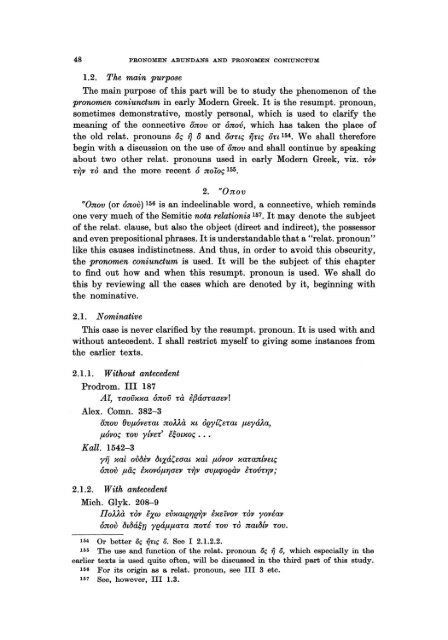Pronomen Abundans and Pronomen Coniunctum. A ... - DWC
Pronomen Abundans and Pronomen Coniunctum. A ... - DWC
Pronomen Abundans and Pronomen Coniunctum. A ... - DWC
Create successful ePaper yourself
Turn your PDF publications into a flip-book with our unique Google optimized e-Paper software.
48 PRONOMEN ABUNDANS AND PRONOMEN CONIUNCTUM<br />
1.2. The main purpose<br />
The main purpose of this part will be to study the phenomenon of the<br />
pronomen coniunctum in early Modern Greek. It is the resumpt. pronoun,<br />
sometimes demonstrative, mostly personal, which is used to clarify the<br />
meaning of the connective 8nov or ónov, which has taken the place of<br />
the old relat. pronouns 8ç f} 8 <strong>and</strong> 8crclÇ ijnç 8n 1M • We shall therefore<br />
begin with a discussion on the use of 8nov <strong>and</strong> shall oontinue by speaking<br />
about two other relat. pronouns used in early Modern Greek, viz. -ro"<br />
-r~" -ro <strong>and</strong> the more recent ó notoç 155.<br />
2. "Onov<br />
"Onov (or ónov) 156 is an indeclinable word, a connective, which reminds<br />
one very much of the Semitic nota relationis l57 • It may denote the subject<br />
of the relat. clause, but also the object (direct <strong>and</strong> indirect), the possessor<br />
<strong>and</strong> even prepositional phrases. It is underst<strong>and</strong>able that a "relat. pronoun"<br />
like this causes indistinctness. And thus, in order to avoid this obscurity,<br />
the pronomen coniunctum is used. It will be the subject of this chapter<br />
to find out how <strong>and</strong> when this resumpt. pronoun is used. We shall do<br />
this by reviewing all the cases which are denoted by it, beginning with<br />
the nominative.<br />
2.1. Nominative<br />
This case is never clarified by the resumpt. pronoun. It is used with <strong>and</strong><br />
without antecedent. I shall restrict myself to giving some instances from<br />
the earlier texts.<br />
2.1.1. Without antecedent<br />
Prodrom. III 187<br />
Ai, -raovxxa ónov -rà lf3áa-raa8v!<br />
Alex. Comn. 382-3<br />
8nov OVfL6v8-ral no'uà Xl oey{C8-rat fL8yáJ..a,<br />
fL6voç -rov y{V8t' UOlXOÇ .••<br />
Kall. 1542-3<br />
yij xal ovbÈv blxáC8aal xal fL6vov xa-rantvuç<br />
ónoV fLäç lxov6f11JC18'V dl" aVfLf/Joeàv ÈTov-r1]v;<br />
2.1.2. With antecedent<br />
Mich. Glyk. 208-9<br />
IIoÎo.Îo.à -rov [xw eVxale1]~V<br />
8X8lVOV -rov yovÉav<br />
ónov blM~n yeáfLfLa-ra nod -rov -ro naLMv -rov.<br />
-----<br />
164 Or better 8ç i/nç ö. See I 2.1.2.2.<br />
155 The use <strong>and</strong> function of the relat. pronoun 8ç ij ö, which especially in the<br />
earlier texts is UBed quite of ten , will be discussed in the third part of this study.<br />
168 For its origin as arelat. pronoun, see 111 3 etc.<br />
151 See, however, 111 1.3.
















